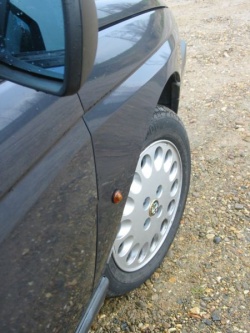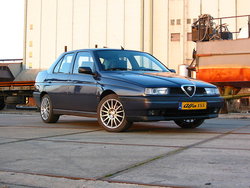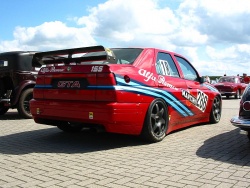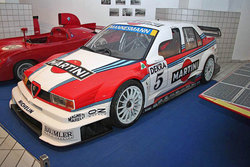Alfa Romeo 155
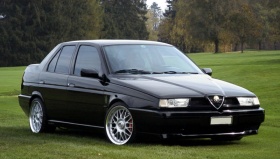
| |
| Alfa Romeo 155 | |
|---|---|
| Manufacturer: | Alfa Romeo |
| Production: | 1992–1998 |
| Body Styles: | FF mid-size sedan |
| Predecessors: | Alfa Romeo 75 |
| Successors: | Alfa Romeo 156 |
| Competitors: | Audi A4 BMW 3 Series Citroën Xantia Ford Mondeo Mercedes-Benz C-Class |
| Alfa Romeo 155 | |
The Alfa Romeo 155 is a compact executive car produced under the Italian Alfa Romeo marque between 1992 and 1998.
Design
Built to replace the 75 and based on the parent Fiat Group's Tipo platform, the 155 was somewhat larger in dimension than the 75 but evolved its styling from that of its predecessor. The 155 was designed by Italian design house I.DE.A Institute. A exceptional drag coefficient of 0.29 was achieved with the body design.
The single most significant technical change from the 75 was the change to a front-wheel drive layout. This new configuration gave cost and packaging benefits but many Alfa die-hards and the automotive press lamented the passing of the "purer" rear-wheel drive layout on a car from this sporting marque — the 155 was considered not in the tradition of Alfa's sporting saloons.Template:Fact
Also available was the 155 Q4 which had a 2.0 litre turbocharged engine and a permanent four-wheel drive powertrain both derived from the Integrale; it was essentially a Lancia Integrale with a different body.
The new model came in "Sport" and "Super" guises. The Sport had a slightly lowered ride height and more aggressive dampers while the Super had the option of wooden trim and electronically controlled dampers and seat controls.
Reception of the new model was generally luke-warm. The 75 had been conceived prior to Fiat's acquisition of the Alfa brand, so as "the last real Alfa" it cast rather a shadow over the 155; the loss of rear-wheel drive was frequently cited as the main cause of the disappointment. Nevertheless, the 155 was entered in Touring Car racing and was successful in every major championship it entered which gradually improved its image.
Belatedly the factory introduced a wider version in 1995 (the "wide-body") which as well as a wider track and revised steering based on racing experience or requirements, also brought in new 16-valve engines for the 1.8 and 2.0 litre and also some improvements to cabin materials and build quality. The Q4 was discontinued but the V6 continued.
There were several Sport Packs available, including a race-inspired body kit (spoiler and side skirts) and black or graphite coloured 16" Speedline wheels. The more genteel could opt for the Super which came with wood inserts in the cabin and silver painted alloy wheels.
The 155 was never produced as a Sportwagon (Alfa's term for an estate / station wagon) but Sbarro made a proposal for such a vehicle in 1994.
Production of the 155 ceased in 1998 when the 155 was replaced by the 156 which was a further development in terms of quality and refinement and finally moved away from the wedge styling — leaving the 155 as the pinnacle of that particular design stream which dated back to 1977 with the dramatic square styling of the Giulietta Nuova.
Timeline
- 1992: 155 launched
- 1993: Grill changed from flushed to recessed
- 1994: 155 Silverstone introduced to the British market, 155 Q4 and turbodiesels to some markets
- 1995: New "widebody" series 2 155 launched with wider track, initially only with 2.0 16v engine. Quickrack fitted
- 1996: Widebody with 1.8 16v engine introduced
- 1998: Production ends
Features
The 155 was initially released with 1.7 L Twin Spark, 1.8 L Twin Spark, and 2.0 L Twin Spark petrol engines, the latter two with variable valve timing. The 1.7 L was not sold in the United Kingdom.
Two four-cylinder turbocharged diesel engines, of 1.9 L (92PS) and 2.5 L (125PS) were available in some markets, but again not the UK.
At the top of the 155 range were the 2.5 L V6, using a (166PS) engine derived from the 3.0 L V6 used in the larger Alfa Romeo 164, and the Q4 which used a drivetrain derived from the Lancia Delta Integrale which meant a 190PS 2.0 L 16V turbocharged engine and permanent four-wheel drive. The Q4 also incorporated three differential gears (normal at the front, epicyclic at the centre (including a Ferguson viscous coupling) and torsen self-locking at the rear). Both the 2.5 V6 and Q4 models were also available with electronically adjustable suspension with two damper settings (automatic and sport).
The most notable special edition was the "Silverstone" edition released in the UK which was known as the "Formula" in Europe: this was released as a homologation exercise to allow Alfa Romeo to compete in the British Touring Car Championship race series and consequently came with a bolt-on aero-kit comprising of an adjustable rear spoiler and extendible front air splitter.
The Silverstone was a lighter but no more powerful version of the 1.8 L, even though the race car it was homologating had a 2.0 L engine. This anomaly came about because the 1.8 L engine block, with its narrower bore, allowed Alfa to use a longer stroke on the racing car and stay within the 2.0 L capacity limit.
The Silverstone was only available in either Alfa red or Black paintwork with plain, unpainted bumpers.
1995 Facelift
In 1995 the 155 was given an extensive revamp resulting in wider front and rear tracks with subtle enlargement to the wheel arches to accommodate the changes underneath.
The revised car also received a quicker steering rack, with 2.2 turns lock to lock (initially only on the 2.0 , but later followed by the 1.8 L). The 4-cylinder cars retained the twin spark ignition system but received Alfa-designed 16-valve cylinder heads with belt-driven camshafts based on engine blocks of Fiat design. They replaced the elderly but indestructible all-Alfa 8-valve, chain-driven camshaft motors of the earlier models.
The 2.5 L v6 continued in wide body form (but without the steering changes) while the Q4 was discontinued. In Europe the 1.7 L Twin Spark was replaced by a 1.6 L 16-valve Twin Spark. Some 8-valve engines continued in a wide body car in some markets.
The wide-bodied cars also received revised interiors and equipment specifications to keep the cars competitive in the showroom.
The wide body ("Series 2") 155s can be distinguished from their earlier counterparts by their flared front and smooth rear wheel arches (the latter replacing the lip round the wheel arch of the original). They also sported round or oblong indicator side-repeaters and had their model badges moved to below the rear lights rather than having them above.
Engines
| Model | Engine | Volume | Power | Torque | 0-100 km/h, s | Top speed | Note |
|---|---|---|---|---|---|---|---|
| 1.7 8V | I4 | 1749 cc | 84 kW (115 PS) @6000 rpm | 146 Nm @3500 rpm | 10.6 | 191 kmh | |
| 1.8 8V | I4 | 1773 cc | 98 kW (129 PS) @6000 rpm | 165 Nm @5000 rpm | 10.3 | 200 kmh | |
| 2.0 8V | I4 | 1995 cc | 104 kW (143 PS) @6000 rpm | 187 Nm @5000 rpm | 9.3 | 205 kmh | |
| 2.5 V6 | V6 | 2492 cc | 120 kW (166 PS) @5800 rpm | 216 Nm @4500 rpm | 8.4 | 215 kmh | |
| Q4 | I4 | 1995 cc | 137 kW (190 PS) @6000 rpm | 291 Nm @2500 rpm | 7.0 | 225 kmh | |
| 1.6 16V | I4 | 1598 cc | 88 kW (120 PS) @6300 rpm | 144 Nm @4500 rpm | 11.4 | 195 kmh | since 1995 |
| 1.8 16V | I4 | 1747 cc | 103 kW (140 PS) @6300 rpm | 165 Nm @4000 rpm | 10.0 | 205 kmh | since 1995 |
| 2.0 16V | I4 | 1970 cc | 110 kW (150 PS) @6200 rpm | 187 Nm @4000 rpm | 9.0 | 210 kmh | since 1995 |
| 2.0 TD | I4 | 1929 cc | 66 kW (92 PS) @4100 rpm | 186 Nm @2500 rpm | 13.5 | 180 kmh | |
| 2.5 TD | I4 | 2500 cc | 92 kW (125 PS) @4200 rpm | 294 Nm @2000 rpm | 10.4 | 195 kmh |
155 TI.Z and GTAZ
Zagato made two special versions of 155. 1993 was introduced 155 TI.Z[1] and 1995 155 GTAZ. Both models had more muscular looking exterior and more power than regular models, the TI.Z had 170PS Twin Spark engine and GTAZ had the 155 Q4's turbocharged two litre engine now producing 215PS. Both models were built only a limited amount and many of the cars were sent to Japan.
155 in motorsport
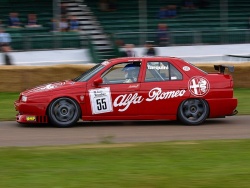
The 155 was very successful in touring car racing, using the Supertouring-homologated GTA and the V6 TI for the DTM. Between 1992 and 1994, the 155 managed to take the Italian Superturismo championship, the German DTM championship (both with Nicola Larini at the wheel), the Spanish Touring Car Championship (with Adrián Campos), and the British Touring Car Championship (with Gabriele Tarquini). The 155 remained competitive until it was replaced with the 156, finishing third in the DTM (then known as the International Touring Car Championship, or ITC) in 1996 with Alessandro Nannini and winning the Spanish championship again in 1997 with Fabrizio Giovanardi. The 156 was to continue the high standard set by the 155, winning the European Touring Car Championship multiple times.
155 V6 TI
The Alfa Romeo 155 V6 TI is a racing car that Alfa Corse used starting from 1993 in DTM season (Deutsche Tourenwagen Meisterschaft) racing series. German Schübel Engineering racing team also entered three 1993 spec cars and one 94 spec car on the 1993 season. The 93 spec 155 had Jägermeister sponsorship livery.
The 1993 season was dominated by Nicola Larini winning 11 of 22 races, another driver on that season in Alfa Corse was Alessandro Nannini.
On the 1995 season the team got new sponsorship livery, Martini Racing, on the 96 season one of the drivers were Christian Danner driving Alfa Corse TV Spielfilm team. The 1996 season was the last for Alfa Romeo.
The 1996 version had a 2.5 L 90° V6 engine delivering 490PS at 11,900 rpm, had a top speed of around 300km/hand weighed 1060kg.
The Alfa 155 V6 TI did a record of 38 wins (plus 3 other non championship races). The victories were obtained by seven different drivers: 17 (+1) Nicola Larini, 13 (+1) Alessandro Nannini, 2 Stefano Modena, 2 (+1) Christian Danner, 2 Michael Bartels, 1 Kris Nissen and 1 Gabriele Tarquini.
1992 Alfa Romeo 155 2L Twin Spark
- 1992 Alfa Romeo 155 2L Twin Spark 1.jpg
- 1992 Alfa Romeo 155 2L Twin Spark 2.jpg
- 1992 Alfa Romeo 155 2L Twin Spark 3.jpg
- 1992 Alfa Romeo 155 2L Twin Spark 4.jpg
- 1992 Alfa Romeo 155 2L Twin Spark 5.jpg
- 1992 Alfa Romeo 155 2L Twin Spark 6.jpg
- 1992 Alfa Romeo 155 2L Twin Spark 7.jpg
- 1992 Alfa Romeo 155 2L Twin Spark 8.jpg
- 1992 Alfa Romeo 155 2L Twin Spark 9.jpg
- 1992 Alfa Romeo 155 2L Twin Spark 10.jpg
- 1992 Alfa Romeo 155 2L Twin Spark 11.jpg
- 1992 Alfa Romeo 155 2L Twin Spark 12.jpg
| <- Previous | Alfa Romeo Automobiles S.p.A., a subsidiary of the Fiat S.p.A. since 1986, car timeline, 1980s-present | ||||||||||||||||||||||||||||||
| Type | 1980s | 1990s | 2000s | ||||||||||||||||||||||||||||
| 0 | 1 | 2 | 3 | 4 | 5 | 6 | 7 | 8 | 9 | 0 | 1 | 2 | 3 | 4 | 5 | 6 | 7 | 8 | 9 | 0 | 1 | 2 | 3 | 4 | 5 | 6 | 7 | 8 | 9 | ||
| Supermini | Junior | ||||||||||||||||||||||||||||||
| Small family car | Alfasud | 33 | 145/146 | 147 | 149 | ||||||||||||||||||||||||||
| Arna | |||||||||||||||||||||||||||||||
| Compact executive car | Alfetta | 75 | 155 | 156 | 159 | ||||||||||||||||||||||||||
| Nuova Giulietta | |||||||||||||||||||||||||||||||
| Executive car | Alfa 6 | 90 | 164 | 166 | 169 | ||||||||||||||||||||||||||
| Coupé | Sprint | GTV (916) | GT | ||||||||||||||||||||||||||||
| GTV | Brera | ||||||||||||||||||||||||||||||
| Cabriolet | Spider (916) | Spider (939) | |||||||||||||||||||||||||||||
| Sportscar | SZ/RZ | ||||||||||||||||||||||||||||||
| Roadster | Spider | ||||||||||||||||||||||||||||||
| Supercar | 8C Competizione and Spider | ||||||||||||||||||||||||||||||
| Racing car | 179/182/183T/184T/185T | SE 048SP | |||||||||||||||||||||||||||||
